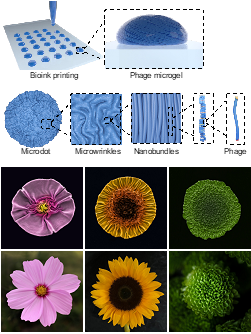Turning biomolecules into 3D hierarchical wrinkled structures

Tech ID
22-061
Inventors
Zeinab Hosseinidoust
Tohid Didar
Lei Tian
Patent Status
US provisional filed
Development Status
Proof of concept available
Contact
Amy Hector
Business Development Manager
Abstract
Hierarchically structured materials, such as wrinkled structures, are nature’s way of packing a very high surface area into a small footprint. The existing methods for making artificial wrinkled structures, however, are designed for polymers and metals and thus inherently incompatible with biomolecules. Most such methods are reliant on high temperatures and/or organic solvents and are harsh and disruptive towards biologics such as proteins, nucleic acids, or viruses.
Researchers at McMaster have invented a transformative method, free of heat and solvents, that allowed for the preservation of micro and nanostructure of biologics while inducing substrate wrinkling. A phage bioink was used to print soft phage microarrays with controllable size on prestressed polystyrene substrates. Subsequent substrate shrinkage induced 2D phage microarrays to fold into complex 3D flower-like structures. The functional phage microarray was demonstrated for its ability to detect Legionella bacteria from industrial water samples.
Applications of the invented method
- Wrinkling biologics with no disruption to micro/nanoarchitecture
- Developing functional/bioactive wrinkled material
- Wrinkling any heat or solvent sensitive material, not limited to biologics
Applications of realized hierarchical material
- Scaffolds for novel electrodes, catalysts, and energy storage materials
- Smart textile and wearable tech
- Bioactive interface for biosensing and in bioassays
- Drug delivery
- Surface-enhanced Raman spectroscopy
- Bioactive cell culture substrates
Advantages
- Heat-free: maximum temperature is 35 degrees Celsius, which is friendly to heat-sensitive materials.
- Dehydration and wrinkling can be achieved at the same time, advantageous for hydrogels.
- Preserves sophisticated molecular, nano, and micro structures during wrinkling.
- Diverse wrinkle morphology easily achievable by controlling the parameters.


